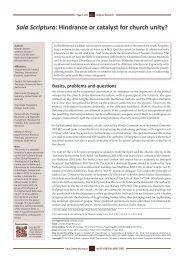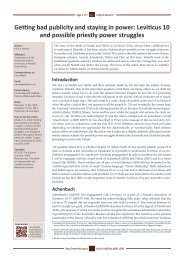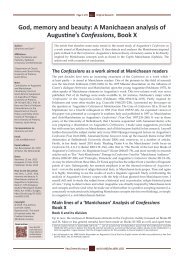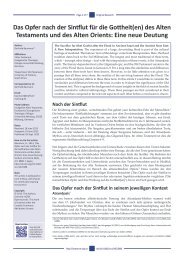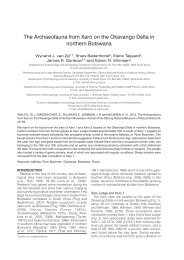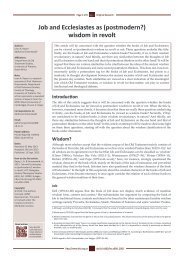Development of a Rift Valley fever real-time RT-PCR assay that can ...
Development of a Rift Valley fever real-time RT-PCR assay that can ...
Development of a Rift Valley fever real-time RT-PCR assay that can ...
Create successful ePaper yourself
Turn your PDF publications into a flip-book with our unique Google optimized e-Paper software.
428 W.C. Wilson et al. / Journal <strong>of</strong> Virological Methods 193 (2013) 426–431<br />
Table 1<br />
RVFV primers for <strong>real</strong> <strong>time</strong> <strong>RT</strong>-<strong>PCR</strong>.<br />
Primer Orient Final conc. (M) T m ( ◦ C) Nucleotide sequence 5 ′ –3 ′<br />
RVFL-2912fwdGG a Forward 10 53.1 TGA-AAA-TTC-CTG-AGA-CAC-ATG-G<br />
RVFL-2981revAC Reverse 10 52.7 ACT-TCC-TTG-CAT-CAT-CTG-ATG<br />
RVFV-M(G2)-F(RVAs) Forward 10 56.2 CAC-TTC-TTA-CTA-CCA-TGT-CCT-CCA-AT<br />
RVFV-M(G2)-R (RVS) Reverse 10 56.3 AAA-GGA-ACA-ATG-GAC-TCT-GGT-CA<br />
RVFV-S(NSs)-F Forward 20 55.7 TGA-TGG-TCC-TCC-CAG-GAT-AC<br />
RVFV-S(NSs)-R Reverse 20 55.8 ACT-AGG-ACG-ATG-GTG-CAT-GA<br />
RVF-MP12-3296F b Forward 10 53.6 CCT-CAC-TAT-TAC-ACA-CCA-TTC<br />
RVF-MP12-3453R b Reverse 10 50.5 ATC-ATC-AGC-TGG-GAA-GCT<br />
a RVF L segment primers and probes identical to Bird et al. (2007a,b). RVF M primers and probes identical to Drosten et al. (2002).<br />
b RVF-MP12 primers substituted for RVFL primers when RNA from RVFV MP-12 vaccine strain was used.<br />
Table 2<br />
RVFV probes for <strong>real</strong> <strong>time</strong> <strong>RT</strong>-<strong>PCR</strong>.<br />
Probe Fluorescent reporter dye (5 ′ end) Quencher (3 ′ end) Final conc. (M) T m ( ◦ C) Nucleotide sequence 5 ′ –3 ′<br />
RVFL-probe-2950 CAL FLUOR RED 610 BHQ2 10 62.9 CAA-TGT-AAG-GGG-CCT-GTG-TGG-ACT-TGT-G<br />
RVFV-M(G2) FAM BHQ1 1 63.7 AAA-GCT-TTG-ATA-TCT-CTC-AGT-GCC-CCA-A<br />
RVFV-S(NSs) QUASAR 670 BHQ2 10 62.5 TCC-TGG-CCT-CTT-GGA-GAA-CCC-TC<br />
RVF-MP12-3371P CAL FLUOR RED 610 BHQ2 5 62 CTG-AGA-TGA-GCA-AGA-GCC-TGG-TTT-GTG-A<br />
2.5. Real-<strong>time</strong> reverse transcriptase-polymerase chain reaction<br />
(r<strong>RT</strong>-<strong>PCR</strong>)<br />
Final analysis was done after combining the RVFV triplex L, M<br />
and S primers and probes and one <strong>of</strong> the external RNA control combinations.<br />
The r<strong>RT</strong>-<strong>PCR</strong> was conducted using AgPath ID r<strong>RT</strong>-<strong>PCR</strong><br />
Kit (Life Technologies, Inc., Grand Island, NY) and cycle <strong>time</strong>s <strong>of</strong><br />
45 ◦ C for 10 min, 95 ◦ C for 10 min, followed by 40 cycles <strong>of</strong> 95 ◦ C for<br />
10 s and 60 ◦ C for 1 min. Diagnostic test evaluation statistics was<br />
calculated (MedCalc S<strong>of</strong>tware, Mariakerke, Belgium).<br />
3. Results<br />
3.1. Multiplex r<strong>RT</strong>-<strong>PCR</strong> development and optimization<br />
A one-step multiplex <strong>RT</strong>-<strong>PCR</strong> was initially developed based on<br />
previous <strong>real</strong>-<strong>time</strong> <strong>assay</strong>s (Bird et al., 2007a; Drosten et al., 2002;<br />
Garcia et al., 2001). The primer-probe set targeting the S-segment<br />
did not perform consistently in the triplex <strong>assay</strong>s. To further evaluate<br />
the design, alignments were made <strong>of</strong> all full-length sequences <strong>of</strong><br />
the RVFV L, M and S RNA segments available from Genbank. Highly<br />
conserved regions were then identified for use in designing the<br />
<strong>real</strong>-<strong>time</strong> <strong>assay</strong>. These conserved segments were exported to VisualOMP<br />
and underwent further analysis for <strong>real</strong>-<strong>time</strong> development<br />
in silico. Further optimization was conducted piecewise with L, M<br />
and S in vitro, with plasmids containing half- to full-length genome<br />
segments from virulent strains <strong>of</strong> RVFV to determine feasibility for<br />
multiplexing. No signifi<strong>can</strong>t sequence interactions were found after<br />
a BLAST search with the final designed primers. Plasmid DNA was<br />
serially diluted 6-fold and tested with various primers and probes<br />
individually and then multiplexed; multiple chemical and process<br />
parameters were evaluated during the optimization. After initial<br />
optimization with plasmid DNA, MP-12 total RNA was extracted<br />
from MRC5 cells at 80–95% CPE using Trizol LS following the manufacturer’s<br />
protocol. This total RNA was serially diluted 6-fold<br />
and tested in the same fashion as for cDNA optimization. Optimal<br />
primer and probe set sequences <strong>can</strong> be found in Tables 1 and 2.<br />
3.2. Quadruplex <strong>assay</strong> with evaluation <strong>of</strong> an exogenous armored<br />
enterovirus RNA control<br />
Once the <strong>assay</strong> was optimized using the model system<br />
it was evaluated in laboratories in RVF endemic countries with<br />
authorization to work with virulent RVFV. The first design using the<br />
triplex for all three genome segments with different reporter dyes<br />
for each segment was evaluated in the Kenya Agricultural Research<br />
Institute (KARI). It was determined <strong>that</strong> the <strong>assay</strong> is able to detect<br />
Smithburn vaccine and Kenya 2007 outbreak strains <strong>of</strong> RVFV. The<br />
<strong>assay</strong> did not cross-react with Nairobi sheep disease virus <strong>that</strong> also<br />
causes hemorrhagic disease in ruminants. The condition <strong>of</strong> some <strong>of</strong><br />
the samples clearly indicated <strong>that</strong> an external control was needed<br />
to control for <strong>RT</strong>-<strong>PCR</strong> inhibition. Previously, exogenous armored<br />
enterovirus RNA (Asuragen, Austin, TX) was successfully employed<br />
in a single-plex r<strong>RT</strong>-<strong>PCR</strong> <strong>assay</strong> (Drolet et al., 2012); therefore, it<br />
was decided to use the same control in this <strong>assay</strong>. The limit <strong>of</strong><br />
detection <strong>of</strong> the quadruplex <strong>assay</strong> with viral RNA extracted from<br />
diluted titered stock <strong>of</strong> RVFV South Afri<strong>can</strong> strain AR 20368 was 0.5<br />
TCID 50/ml (Fig. 1). No cross-reaction was found when the quadruplex<br />
<strong>assay</strong> was evaluated against a panel <strong>of</strong> nine other abortogenic<br />
or hemorrhagic viral agents (Table 3). In a separate experiment, a<br />
sample known to be positive for Nairobi Sheep disease virus also<br />
tested negative with the triplex <strong>real</strong>-<strong>time</strong> <strong>RT</strong>-<strong>PCR</strong> <strong>assay</strong>. The ability<br />
<strong>of</strong> the <strong>assay</strong> to detect RVFV strains from varying geographical<br />
locations isolated over a period spanning 63 years was evaluated<br />
(Table 4). The <strong>assay</strong> did not consistently detect the S segment when<br />
the exogenous armored enterovirus RNA control was used. To<br />
compensate for this problem at this <strong>time</strong> the triplex <strong>assay</strong> design<br />
(excluding armored enterovirus RNA, primer and probe) was used<br />
for further evaluation. Thirty positive and 15 negative human<br />
sera samples, tested at the National Institute for Communicable<br />
Diseases (NICD) in South Africa and confirmed by the previously<br />
validated reverse transcriptase loop-mediated amplification <strong>assay</strong><br />
CtValue<br />
40<br />
30<br />
20<br />
10<br />
0<br />
0 1 2 3 4 5<br />
TCID50/ml<br />
L (CT)<br />
M (CT)<br />
S (CT)<br />
Fig. 1. Example <strong>of</strong> limit-<strong>of</strong>-detection analysis using RNA extracted from 10-fold<br />
dilutions <strong>of</strong> titered <strong>Rift</strong> <strong>Valley</strong> <strong>fever</strong> virus.



